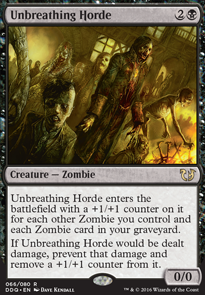While rules for fighting The Horde can vary and change, there are a few rules that can be customized. Feel free to talk to your group if any rule or card seems too harsh or easy and decide for yourselves how to correct it. This horde list and these rules are by no means what you have to use, you are free to make your own list or rules if you desrire.
- The amount of cards within The Horde's deck varies according to the amount of players. For example, this 200 card deck is designed for facing 4 people, so against 2 people The Horde would only have a 100 card deck and it would have 300 cards against 6 people.
- The Horde begins with no lands or nonlands present on the battlefield and has no cards in its hand.
- The Horde is not technically seen as a player for alternate win conditions, meaning you can't just attack with Phage, the Untouchable or use a card like Barren Glory.
- The Horde is immune to "easy win" cards such as Lightmine Field. Determine what fits this category with your playgroup and go from there.
- If The Horde would take any damge, instead that many cards are sent from the top of The Horde's deck to its graveyard. This is the primary way that players are able to fight against The Horde and is highly advised to be careful when attacking The Horde, since while cards like Noxious Ghoul and Vengeful Dead are never preferred to be cast by The Horde, it may also mean a Living Death or Rise of the Dark Realms in the future. In the event of The Horde drawing cards and receiving damage at the same time (ie. Graveborn Muse), it will first draw the cards and then receive the damage. Players can choose to attack the horde if they wish to clear out more of The Horde's options, but must be careful when doing so.
- The Horde has infinite black mana at any and all given times. This means that Cards like Sphere of Safety or Propoganda offer no form of refuge against anyone but the other players at the table. If The Horde is forced to cast a spell with "X" in the mana cost, "X" is considered to be zero unless it is casting some form of creature, in which case it should be considered the maximum reasonable amount as determined by the group (The Horde doesn't need to suddenly have a creature with over 1,000 power and toughness, but it shouldn't get a creature with 0 power and toughness either unless the cards flip that way). Since the horde is casting these cards, you can counter them.
- After the 4th turncycle, The Horde will begin taking turns in between player turns (In example for the fourth turn of a four-player game's new turnorder: Player 1, The Horde, Player 2, The Horde, Player 3, The Horde, Player 4, The Horde). In these turns, The Horde takes a relatively normal turn: First, the horde will draw a certain amount of cards depending on how far the game has progressed. After, The Horde simotaneously "casts" all of those cards in the order they were flipped (for example, if the horde's first draw was a Shambling Ghoul and the second draw was a Living Death, the Shambling Ghoul is set to resolve before the Living Death). After the hand has been cast, The Horde will then cast any cards in its graveyard with can be cast, and it will prioritze any creatures (However, cards with flashback will only be cast if they were not placed into the graveyard by The Horde casting them that turn). Next, The Horde will attack with any creatures that are not currently summoning sick on its board (more details below). Afterwards, The Horde will proceed to the post-combat main phase and cast any cards
currently within its hand (such as if something was bounced by Cyclonic Rift during combat).
- If someone has died during the game, The Horde will still take multiple turns as though that player were alive. Such as if Player 3 had perished, The Horde would still take its turn for after Player 2's turn, but it would then take another turn as though Player 3 immediately passed their turn after The Horde's current turn.
- Any actions that The Horde would take are decided randomly based on a dice roll, such as who The Horde attacks each turn or who it sacrifices to an edict effect. The Horde will only attack one player, but if planeswalkers are on the battlefield, The Horde attacks the planeswalker with a random amount of zombies based on the number of loyalty counters that planeswalker has in addition to the player chosen (If a planeswalker has 5 loyalty counters, 5 zombies will attack it).
- If The Horde has an effect to save one of its own, such as Boneknitter, The Horde will always do so and will always save whatever is being targeted or everything applicable in the event of a wrath effect.

